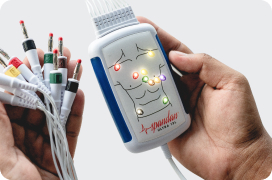
Author:- Mr. Ritesh Sharma
Pulmonary Embolism is an under-discussed condition that is reflected through pulmonary embolism ECG. This medical condition is mostly associated with the formation of blood clots, particularly in the region of the legs. These blood clots travel to the lungs and obstruct the pulmonary arteries, hence the medical condition is referred to as pulmonary embolism. While from the name, it doesn’t sound like a condition that will detected through pulmonary embolism ECG, it is the major diagnostic tool for it.
Accurate and prompt diagnosis is crucial for effective management and improved patient outcomes. While imaging techniques like CT pulmonary angiography are gold standards for diagnosing PE, an electrocardiogram (ECG) can provide critical initial clues, especially in emergency settings. This blog explores the key ECG patterns associated with pulmonary embolism and their diagnostic significance.
Understanding Pulmonary Embolism
Before diving into the Pulmonary Embolism ECG patterns, it’s essential to grasp the basics of pulmonary embolism. PE occurs when a thrombus (blood clot) lodges in the pulmonary arteries, impeding blood flow to the lung tissue. This obstruction can lead to a cascade of physiological responses, including increased pulmonary artery pressure, right ventricular strain, and hypoxemia. Recognizing the ECG signs of PE can expedite diagnosis and treatment, reducing the risk of severe complications or death.
The Role of ECG in Diagnosing Pulmonary Embolism
An ECG is a quick, non-invasive tool that records the electrical activity of the heart. Although it cannot definitively diagnose PE, it can indicate the presence of right heart strain and other abnormalities that suggest PE. The abnormal ECG findings in PE are often nonspecific but, when interpreted in the clinical context, can raise suspicion and prompt further diagnostic testing.
Pulmonary Embolism ECG Patterns
Sinus Tachycardia
The most common ECG finding in PE is sinus tachycardia, which is present in about 40% of cases. This nonspecific finding indicates an elevated heart rate, often a physiological response to hypoxemia, pain, or anxiety associated with PE. While not diagnostic on its own, sinus tachycardia should raise suspicion of PE in the appropriate clinical context.
S1Q3T3 Pattern
The classic S1Q3T3 pattern is seen in about 10-20% of PE cases and is considered highly suggestive of PE. This pattern involves:
- S wave in lead I: A prominent S wave.
- Q wave in lead III: A pronounced Q wave.
- T wave inversion in lead III: An inverted T wave.
- This triad suggests acute right ventricular strain due to obstruction of the pulmonary vasculature, causing right heart overload.
Right Bundle Branch Block (RBBB)
Right bundle branch block, either complete or incomplete, can be observed in PE. This pattern indicates delayed conduction through the right ventricle, which may be secondary to increased right ventricular pressure and strain. RBBB is seen more frequently in massive or submassive PE cases.
Right Ventricular Strain Pattern
Right ventricular strain pattern encompasses several ECG changes, including:
- T wave inversions in V1-V4: These are indicative of right ventricular ischemia or strain.
- T wave inversions in the inferior leads (II, III, aVF): These changes further point to right heart strain.
P Pulmonale
P pulmonale refers to peaked P waves (>2.5 mm) in lead II, indicating right atrial enlargement. This pattern suggests increased right atrial pressure secondary to right ventricular overload in PE.
Atrial Fibrillation
Atrial fibrillation (AF) can occur in the setting of PE due to increased right atrial pressure and hypoxia. Although AF is a common arrhythmia and not specific to PE, its new onset in a patient with risk factors for thromboembolism should raise the index of suspicion for PE.
Low Voltage QRS
Low voltage QRS complexes across the limb leads may be observed in PE, particularly in cases complicated by pericardial effusion secondary to right heart failure. This finding indicates reduced electrical activity reaching the body surface, often due to fluid accumulation or other pathological changes.
Non-specific ST-segment and T-wave Changes
Non-specific ST-segment and T-wave changes are frequently seen in PE but lack specificity. These may include ST-segment elevation or depression and T-wave inversions in various leads indicating T-wave abnormalities, reflecting generalized cardiac stress.
Interpreting ECG Findings in Clinical Context
While these ECG patterns can point toward PE, they are not diagnostic in isolation. It is crucial to integrate ECG findings with clinical presentation, risk factors, and other diagnostic modalities. For instance, a patient presenting with sudden onset dyspnea, chest pain, and a high pre-test probability of PE who demonstrates the S1Q3T3 pattern on ECG warrants urgent imaging studies like CT pulmonary angiography or a V/Q scan.
Advanced Diagnostic Techniques
Despite the valuable clues provided by an ECG, advanced imaging remains the cornerstone of PE diagnosis. CT pulmonary angiography is the preferred modality, offering high sensitivity and specificity for detecting emboli in the pulmonary arteries. In scenarios where CT is contraindicated, a ventilation-perfusion (V/Q) scan can be an alternative. Additionally, bedside echocardiography can reveal signs of right ventricular dysfunction, supporting the diagnosis of PE in critically ill patients.
In conclusion, Recognizing the pulmonary embolism ECG patterns can expedite diagnosis and initiate prompt management, potentially saving lives. Sinus tachycardia, S1Q3T3 pattern, right bundle branch block, right ventricular strain, P pulmonale, atrial fibrillation, low voltage QRS, and non-specific ST/T changes are key ECG findings to watch for. However, these patterns should be interpreted within the broader clinical context, considering the patient’s history, symptoms, and risk factors. Advanced imaging remains essential for definitive diagnosis, but the ECG serves as a critical initial tool in the evaluation of suspected pulmonary embolism.




